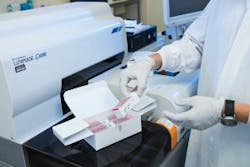Procalcitonin serial testing to inform treatment of sepsis
Earning CEUs:
To earn CEUs, visit www.mlo-online.com under the CE Tests tab.
LEARNING OBJECTIVES
Upon completion of this article, the reader will be able to:
Sepsis, also known as blood poisoning or septicemia, is defined as life-threatening organ dysfunction caused by a dysregulated host response to infection.1 Sepsis continues to be the leading cause of death in U.S. hospitals, representing around 25 percent of patients.2-3 According to the CDC, of the 1.7 million American adults that develop sepsis, 270,000 die each year.4
The primary infections that lead to sepsis are respiratory (35 percent), genitourinary (25 percent), gastrointestinal (11 percent), and infections of the skin (11 percent).2,4 The average length of hospital stay for patients with sepsis is considerable, at around 9 days.4 With an annual cost of hospital care for sepsis patients estimated at around $24 billion in the U.S., the condition places a significant burden on the healthcare system.5 However, with rapid diagnosis and treatment, as many as 80 percent of sepsis deaths could be prevented.3
Antimicrobial resistance contributes to sepsis mortality rates
Effective treatment for sepsis requires timely administration of a suitable antibiotic to prevent a rapid, often fatal deterioration in a patient’s clinical condition. However, the emergence of antimicrobial resistance (AMR) renders many antibiotics ineffective. Fueled by poor antibiotic stewardship—administering antibiotics unnecessarily or prescribing the wrong antibiotic at the wrong dose, and for the wrong duration—AMR has considerable potential to impact sepsis mortality rates.6
CDC estimates that 20-50 percent of acute-care hospital antibiotic prescriptions and 30 percent of outpatient antibiotic prescriptions in the U.S. are unnecessary, mostly caused when antibiotics are inappropriately prescribed for viral infections. Furthermore, it is approximated that more than 70 percent of the bacteria responsible for the two million infections acquired in U.S. hospitals each year are resistant to at least one commonly used antibiotic.7 Unless effective measures are put in place to limit the development of AMR, these numbers are likely to rise.
Associated risks of antibiotic overuse include increases in disease severity, disease length, health complications, re-hospitalization, and the need for medical treatment of health problems that may be resolved on their own. These factors can have a considerable impact on patient quality of life and contribute significantly to added healthcare costs.7 To improve patient outcomes and antibiotic effectiveness, diagnostic and prognostic testing to aid antibiotic therapy decision-making has an essential role.Antibiotic misuse contributes to Clostridium difficile infection
The incidence and severity of Clostridium difficile infection (CDI) has increased dramatically within the past two decades, making the Clostridium difficile bacterium the most common cause of nosocomial infections in developed countries. Responsible for almost half a million infections in the U.S. each year, CDI is associated with significant morbidity and mortality.8
Patients at increased risk of CDI include those receiving antibiotic therapy or patients who are immunocompromised through chemotherapy treatment or HIV infection.9 Due to resultant diarrhea and the development of potentially life-threatening complications such as sepsis, CDI represents a substantial clinical burden.
It has been estimated that excess healthcare costs related to CDI could be as much as $4.8 billion for acute-care facilities alone.10 In a meta-analysis, the average CDI-attributable cost per case was $20,085 for community-acquired CDI and $34,149 for hospital-acquired CDI. These figures were associated with an average length of stay of 5.7 days for community-acquired CDI and 7.8 days for hospital-acquired CDI.11
An average 20.9 percent recurrence rate has been reported for healthcare-associated CDI, resulting in an estimated 61,400 first recurrent infections.10 Given the challenges of treating recurrences, and because almost all antibiotics are associated with an increased risk of CDI, initiatives aimed to reduce CDI incidence should target reduced antimicrobial exposure through effective antibiotic stewardship programs.12
Current methods to identify systemic bacterial infections require improvement
Signs of bacterial and viral infections frequently overlap, including elevated body temperature, heart rate, respiratory rate, and leukocyte count. Although these parameters can be monitored easily, they are often inadequate to determine the nature of the infection. Further information can be gained by culturing urine, cerebrospinal fluid (CSF), bronchial fluid, or blood. However, such tests are time-consuming (up to 48 hours for urine, CSF, and bronchial fluid, 50-60 hours for blood) and negative cultures do not exclude infection.2,13
Since time is crucial when treating sepsis, measurement of a relevant biomarker is far more appropriate.
Common biomarkers of sepsis include c-reactive protein (CRP), lactate, and the cytokine interleukin-6 (IL-6).14 However, all of these have limitations. Relevant elevated CRP levels cannot be measured until 6 to 12 hours after an infectious challenge and takes 24 to 48 hours to peak adding considerable time to diagnosis.15 Lactate is not specific to bacterial infections but instead poor tissue perfusion. Lactate is also elevated in individuals with acute myocardial infarction, hypotension, and heart failure, reducing its utility as a sepsis biomarker.16 Cytokines such as IL-6, tumor necrosis factor-α (TNF-α), IL-1β, and IL-10 show low specificity for bacterial infections and increase only briefly or intermittently.2,14 Furthermore, the variability in the course of time and individual patient kinetics for secretion of cytokines limits their use for diagnosis.
Due to its improved sensitivity, specificity, and kinetics as compared to CRP, lactate, and IL-6, PCT is the preferred biomarker of sepsis. PCT is a 14.5kDa prohormone encoded by the CALC-1 gene, belonging to the calcitonin super-family of peptides. The production of calcitonin is exclusive to the parafollicular cells (C cells) of the thyroid. In healthy individuals, PCT is produced only in the thyroid, but in the presence of an infection may be produced by extra-thyroidal tissues.2,25 In healthy individuals, circulatory PCT levels are very low (0.05ng/mL).2,17
In the presence of bacterial infection, PCT expression is induced in virtually all tissues and organs. This occurs either directly via microbial toxins or indirectly through a humoral or a cell-mediated host immune response. Since non-neuroendocrine parenchymal tissues lack the ability to cleave PCT to calcitonin, a dramatic increase in serum PCT levels result.
In a study comparing IL-6 to procalcitonin as a biomarker of sepsis, PCT demonstrated a far greater specificity of 97 percent vs. 67 percent, and a negative predictive value of 88 percent vs. 39 percent providing substantial support for its utility as a sepsis biomarker.18
In addition to the early and highly specific diagnosis of severe systemic bacterial infection and sepsis, PCT affords the ability to monitor the patient response to antibiotic therapy and the course of the disease.19 Remaining elevated until the bacterial infection resolves, PCT levels have a half-life of 25 – 30 hours2,19 providing physicians with a means to assess the therapeutic effect of treatment.
PCT has utility as a diagnostic guide
Since its identification as a reliable biomarker of sepsis, PCT has been studied in a wide range of infections. These include respiratory infections, post-operative infections, and ventilator-associated pneumonia. Importantly, PCT has also demonstrated proven utility to distinguish bacterial from viral meningitis17 and has been used to evaluate the severity of CDI and other bacterial infections.20,21
A further advantage of PCT over other sepsis biomarkers is its use to diagnose bacterial infection in neutropenic patients.17 Measurement of PCT levels can also be employed to distinguish sepsis from non-infectious systemic inflammatory response syndrome (SIRS) since normal or very low PCT plasma concentrations have a high negative predictive value to rule out SIRS.22 Finally, PCT can be used in the differential diagnosis of urinary tract infections and urosepsis, as well as diagnosing catheter-related bloodstream infections (CRBSI) in critically ill patients.20, 23
PCT serial testing is essential for accurate results
For PCT testing to be effective, a baseline reading followed by serial measurements at 24-hour intervals is necessary. Although the baseline measurement can be used to indicate the presence of a systemic bacterial infection—prompting the initiation of antibiotic therapy—it should not be used in isolation to make clinical decisions. Serial measurements of PCT are essential.24
With effective antibiotic therapy, PCT, with a half-life of 24-hours, should show an approximate reduction of 50 percent with each day of treatment. PCT levels measured daily over the 72-hour treatment regimine should show a decline of 80 percent or more from the initial baseline.21
Antibiotic discontinuation is encouraged when PCT levels have dropped by 80 percent from baseline or are between 0.25 and 0.5 ng/mL, or when levels are >0.5 ng/mL and have dropped by <80 percent from baseline. Discontinuation is strongly encouraged when PCT levels are <0.25 ng/mL or have dropped by 90 percent from baseline reading. Using these FDA-cleared algorithms to guide antibiotic treatment, it has been possible to decrease antibiotic exposure without increasing adverse clinical outcomes for sepsis.21Empowering physicians to assess the severity of sepsis, PCT serial testing appears to be an effective tool to guide clinical decision-making. Because clinical decisions are based upon serial measurements of PCT, it is important to use an immunoassay with high precision and sensitivity. This is especially pertinent when patients exhibit only low levels of the prohormone upon presentation.
PCT serial testing represents a major innovation for antibiotic stewardship
Due to its capacity to differentiate between bacterial and viral infections better than other biomarkers, PCT is an extremely powerful diagnostic assay. In initiating early antibiotic treatment or making an antibiotic switch where necessary, PCT serves as a good prognostic marker in sepsis to predict patients at risk of deteriorating.26 In combination, these features enhance clinical decision-making to promote responsible antibiotic stewardship.
As well as contributing to antibiotic effectiveness, serial monitoring of PCT levels helps improve patient outcomes and reduce adverse effects, such as CDI, AMR, and lower respiratory tract infections (LRTI) through more efficacious treatment. In addition, PCT serial testing positively impacts healthcare utilization and cost-effectiveness for sepsis. This is achieved by reducing antibiotic therapy days, days in the ICU, and days spent on a regular ward, all lowering hospital costs by an estimated 20-30 percent.27
Proven efficacy of PCT serial testing
With a pressing need for hospitals to provide early, effective antibiotic treatment while reducing unnecessary treatment days, high sensitivity and precision are fundamental to serial PCT testing. This is especially important in the lower ranges of PCT, where critical medical decisions to initiate an antibiotic protocol are to be made. A retrospective study of 2,152 patients in a center with an antibiotic stewardship program assessed the impact of incorporating a PCT algorithm to guide antibiotic management, publishing the results in 2017.21 The cohort with PCT testing experienced:
- 47 percent reduction in median days of antibiotic therapy, from 17 to nine days, with an associated reduction in costs of antibiotics
- 50 percent reduction in all-cause 30-day readmission rate, from 22.4 percent to 11.1 percent
- 50 percent reduction in adverse drug events from anti-microbials, from 16.2 to 8.1 percent
- 62 percent reduction in all-cause hospital mortality, from 7.6 to 2.9 percent deaths
- 64 percent reduction in CDI, from 2.5 to 0.9 percent
Although serial PCT testing requires upfront investments such as equipment, supplies, and staff education, these costs are more than offset by downstream savings which do not compromise patient outcomes.27 Incorporating PCT algorithms for antibiotic treatment may be useful in decreasing hospital spending per patient by reducing the number of hospital days, the number of blood cultures, and days on antibiotic therapy.
REFERENCES
- Singer M, Deutschman CS, Seymour CW, et al. The Third International Consensus Definitions for Sepsis and Septic Shock (Sepsis-3), JAMA, 2016;315(8):801-10.
- Jin M, Khan AI. Procalcitonin: use in the clinical laboratory for the diagnosis of sepsis. Lab Med. 2010;41(3):173-177.
- Mayr FB, Yende S, Angus DC. Epidemiology of severe sepsis. Virulence. 2013;5(1):4-11.
- Centers for Disease Control and Prevention. Data & reports for the public: making health care safer. CDC website. https://www.cdc.gov/sepsis/datareports/index.html. Accessed 2/9/2019.
- Torio CM, Moore BJ. National Inpatient Hospital Costs: The Most Expensive Conditions by Payer, 2013. Healthcare Cost and Utilization Project (HCUP). https://www.hcup-us.ahrq.gov/reports/statbriefs/sb204-Most-Expensive-Hospital-Conditions.jsp?utm_source=AHRQ&utm_medium=AHRQSTAT&utm_content=Content&utm_term=HCUP&utm_campaign=AHRQ_SB_204_2016. Accessed 2/9/2019.
- Pradipta IS, Sodik DC, Lestari K, et al. Antibiotic resistance in sepsis patients: evaluation and recommendation of antibiotic use. N Am J Med Sci. 2013;5(6):344-52
- Center for Infectious Disease Research and Policy (CIDRAP). Overuse and overprescribing of antibiotics. CIDRAP website.http://www.cidrap.umn.edu/asp/overuse-overprescribing-of-antibiotics. Accessed 2/9/2019.
- Centers for Disease Control and Prevention. Nearly half a million Americans suffered from Clostridium difficile infections in a single year. CDC website. https://www.cdc.gov/media/releases/2015/p0225-clostridium-difficile.html. Accessed 2/9/2019.
- Baggs J, Jernigan JA, Halpin AL, et al. Risk of Subsequent Sepsis Within 90 Days After a Hospital Stay by Type of Antibiotic Exposure. Clinical Infectious Diseases: An Official Publication of the Infectious Diseases Society of America. 2018;66(7):1004–1012.
- Lessa FC, Mu Y, Bamberg WM, et al. Burden of Clostridium difficile infection in the United States. N Engl J Med. 2015;372(9):825-834.
- Zhang S, Palazuelos-Munoz S, Balsells EM, et al. Cost of hospital management of Clostridium difficile infection in United States—a meta-analysis and modelling study. BMC Infect Dis. 2016;16(1):447.
- Brown K, Valenta K, Fisman D, et al. Hospital ward antibiotic prescribing and the risks of Clostridium difficile infection. JAMA Intern Med. 2015;175(4):626-633.
- Lin GL, McGinley JP, Drysdale SB, Pollard AJ. Epidemiology and Immune Pathogenesis of Viral Sepsis. Front Immunol. 2018;9:2147.
- Blomkalns AL. Sick or not sick?: evolving biomarkers for severe bacterial infection. Emergency Medicine Cardiac Research and Education Group. https://pdfs.semanticscholar.org/1f67/eb51f3f9d88c83af59b0fbaf01a4ef237eeb.pdf?_ga=2.42132389.1009923110.1549572011-1693079622.1549572011. Accessed 2/7/2019.
- Simon L, Gauvin F, Amre DK, et al. Serum procalcitonin and C-reactive protein levels as markers of bacterial infection: a systematic review and meta-analysis. Clin Infect Dis. 2004;39(2):206-217.
- Lazzeri C, Valente S, Chiostri M, Gensini GF. Clinical significance of lactate in acute cardiac patients. World J Cardiol. 2015;7(8):483-489.
- El-Azeem AA, Hamdy G, Saraya M, et al. The role of procalcitonin as a guide for the diagnosis, prognosis, and decision of antibiotic therapy for lower respiratory tract infections. Egypt J Chest Dis Tuberc. 2013;62:687-695.
- Harbarth S, Holeckova K, Froidevaux C, et al. Diagnostic value of procalcitonin, interleukin-6, and interleukin-8 in critically ill patients admitted with suspected sepsis. Am J Respir Crit Care Med. 2001;164(3):396-402.
- Castelli CP, Pognani C, Meisner M, et al. Procalcitonin and C-reactive protein during systemic inflammatory response syndrome, sepsis and organ dysfunction. Crit Care. 2005;8(4):R234-R242.
- Sugimoto K, Adomi S, Koike H, Esa A. Procalcitonin as an indicator of urosepsis. Res Rep Urol. 2013;5:77-80.
- Broyles MR. Impact of procalcitonin-guided antibiotic management on antibiotic exposure and outcomes: real-world evidence. Open Forum Infect Dis. 2017;4(4):ofx213.
- Anand D, Das S, Bhargava S, et al. Procalcitonin as a rapid diagnostic biomarker to differentiate between culture-negative bacterial sepsis and systemic inflammatory response syndrome: a prospective, observational, cohort study. J Crit Care. 2015;30(1):218.e7-12.
- Ozsurekci Y, Oktay Arikan K, Bayhan, C, et al. Can procalcitonin be a diagnostic marker for catheter-related blood stream infection in children? Jornal de Pediatria. 2016;92(4):414–420.
- Rey Galán C. Biomarkers of severe bacterial infection: do they help in clinical practice? An Pediatr (Barc). 2016;84(5):247-248.
- Schuetz P, Maurer P, Punjabi V, et al. Procalcitonin decrease over 72 hours in US critical care units predicts fatal outcome in sepsis patients. Crit Care. 2013;17(3):R115.
- Shiferaw B, Bekele E, Kumar K, et al. The role of procalcitonin as a biomarker in sepsis. J Infect Dis Epidemiol. 2016;2(1):1-4.
- Kip MM, Kusters R, IJzerman MJ, Steuten LM. A PCT algorithm for discontinuation of antibiotic therapy is a cost-effective way to reduce antibiotic exposure in adult intensive care patients with sepsis. J Med Econ. 2015;18(11):944-953.
About the Author



